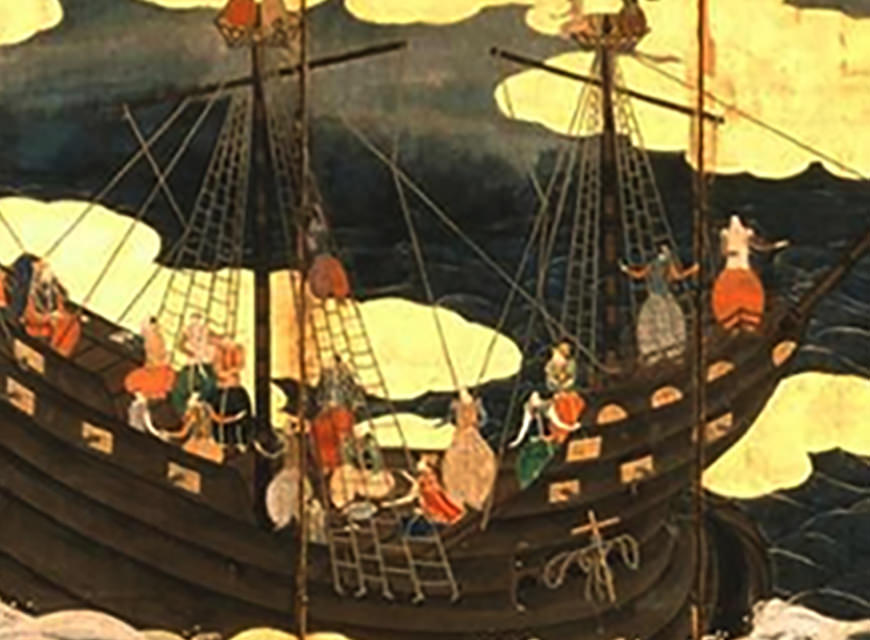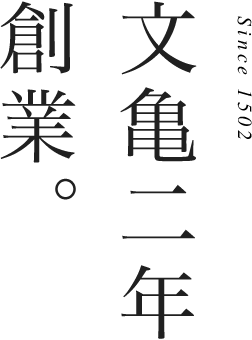Hirado is where the Europeans first traded and western culture was first introduced to Japan. In this nostalgic and historical castle town you can find Tsutaya, a sweetshop founded in 1502 that has long been an official supplier of sweets to the ruling Matsura family of Hirado. Tsutaya is still a much loved local sweetshop and its signature sweet Casdoce has become known throughout Japan. Our mission is to protect and hand down the unchanged taste to the next generations. From our traditional western influenced sweets to new innovative Japanese sweets, we strive for the best quality of each and every product.
Kyushu’s oldest sweetshop 長崎県平戸と九州最古の菓子司

Japan’s oldest international trading port
was a bridge between cultures
Hirado was stopover on maritime trading routes and prospered as an international trading port. The monk Kukai who introduced Shingon Buddhism to Japan left from Hirado to study in China. Centuries later, the monk Eisai, who brought Zen Buddhism to Japan, returned from China to Hirado where he practiced Zen and planted tea plants for the first time in Japan. In the 16th century, the Matsura family protected Chinese traders who set up their base in Hirado. After that the town quickly developed into an international trading port. Trade with the West started soon after in 1550 with the arrival of the first Portuguese ship.

Among the many new products arriving
from Europe were western sweets.
In the 16th and 17th century many ships from Portugal, Spain, Holland and England sailed on Hirado. In 1609 the Dutch Trading Post was established in Hirado, after which Hirado experienced its heyday of international exchange. Among the many new things that the Europeans introduced in Hirado were sweets like castella cake and confeito candy. During that time, Tsutaya started making sweets that were brought to Hirado by the Europeans such as Casdoce, which we continue to make to this day.
Tsutaya and the Book of 100 Sweets
「百菓之図」と蔦屋の菓子

The Book of 100 Sweets shows us the
world of sweets during the Edo period.
Hiromu Matsura was the 35th head of the Matsura family who ruled over the Hirado domain. In 1841 he came up with the idea of creating a book that would list one hundred sweets. Over a period of 6 years this book was painstakingly compiled featuring vivid drawings of the sweets together with their names and recipes. The craftsmen of the sweetshops of Hirado had to make all 100 sweets for this book. The book is still in the collection of the Matsura family and shows Casdoce and Gobo Mochi in the same form as they are made today.
Reproduction project to revive old sweets
from the Book of 100 Sweets.
Tsutaya is undertaking a reproduction project to revive some of the sweets from the “Book of 100 Sweets” that were lost in history. The 41st generation of the Matsura family, Mr. Akira Matsura, is the owner of the book and personally overseas this project. These “revived sweets” are supplied to tea ceremonies of the Chinshin school of tea ceremony that was founded by the Matsura family. You can also enjoy one of the revived sweets called “Ubatama” at the beautiful Kanuntei Teahouse in the garden of the Matsura Historical Museum in Hirado.
Tsutaya and the Chinshin School of Tea
松浦家伝来、武家茶道「鎮信流」と蔦屋

Official supplier of sweets to the Matsura
family; the lords of Hirado
In the Matsura family archives is an old map of Hirado castle town from 1792 on which you can find the name of the owner of Tsutaya at that time: Zensaku Tsutaya. His name also appears in the afterword of the Book of 100 Sweets, which was created between 1841 and 1847 by the Matsura family. Throughout history, documents like this show that Tsutaya has had a strong connection with the rulers of Hirado and were also one of the official suppliers of sweets to them. The Matsura family is an ancient House that traces its origins back to the Imperial family in the 800’s and also enjoyed nobility status after the modernization of Japan.

Chinshin School of Tea,
founded by Shigenobu Matsura.
The Chinshin School of Tea was founded in the 17th century by Shigenobu Matsura who was the lord of Hirado at the time. The Chinshin style of tea ceremony is considered to be a warrior style of tea ceremony, which stays close to the original principles of the way of tea. The Chinshin style tea ceremony has been passed on over the centuries by the Matsura family and they have actively contributed to the development of the tea ceremony, such as by teaching the tea ceremony to the daughters of the Meiji Emperor. The Chinshin School of Tea continues their training till today. As we have done over the past centuries, Tsutaya proudly supplies sweets to their tea ceremonies.
Copylight HIRADO TSUTAYA co.,Ltd. All Right reserved.



